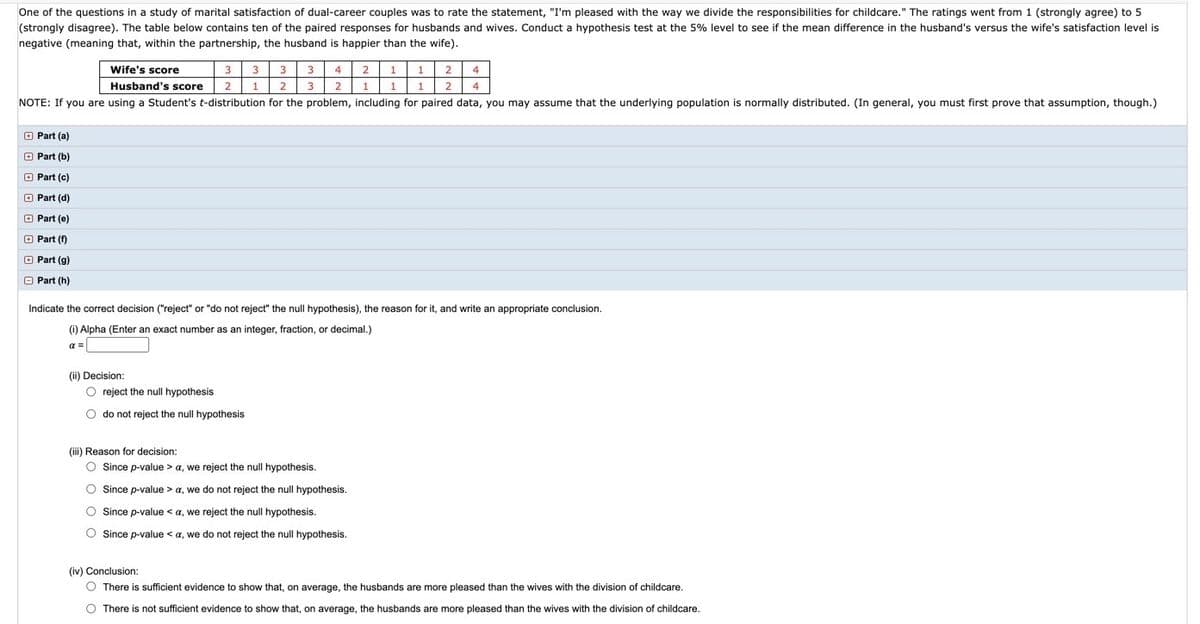One of the questions in a study of marital satisfaction of dual-career couples was to rate the statement, "I'm pleased with the way we divide the responsibilities for childcare." The ratings went from 1 (strongly agree) to 5 (strongly disagree). The table below contains ten of the paired responses for husbands and wives. Conduct a hypothesis test at the 5% level to see if the mean difference in the husband's versus the wife's satisfaction level is negative (meaning that, within the partnership, the husband is happier than the wife). Wife's score Husband's score 21 NOTE: If you are using a Student's t-distribution for the problem, including for paired data, you may assume that the underlying population is normally distributed. (In general, you must first prove that assumption, though.) O Part (a) O Part (b) O Part (c) O Part (d) O Part (e) O Part () O Part (g) O Part (h) Indicate the correct decision ("reject" or "do not reject" the null hypothesis), the reason for it, and write an appropriate conclusion. (1) Alpha (Enter an exact number as an integer, fraction, or decimal.) a= (ii) Decision: O reject the null hypothesis O do not reject the null hypothesis (ii) Reason for decision: p-value > a, we reject the null hypothesis. O Since p-value > a, we do not reject the null hypothesis. O Since p-value
One of the questions in a study of marital satisfaction of dual-career couples was to rate the statement, "I'm pleased with the way we divide the responsibilities for childcare." The ratings went from 1 (strongly agree) to 5 (strongly disagree). The table below contains ten of the paired responses for husbands and wives. Conduct a hypothesis test at the 5% level to see if the mean difference in the husband's versus the wife's satisfaction level is negative (meaning that, within the partnership, the husband is happier than the wife). Wife's score Husband's score 21 NOTE: If you are using a Student's t-distribution for the problem, including for paired data, you may assume that the underlying population is normally distributed. (In general, you must first prove that assumption, though.) O Part (a) O Part (b) O Part (c) O Part (d) O Part (e) O Part () O Part (g) O Part (h) Indicate the correct decision ("reject" or "do not reject" the null hypothesis), the reason for it, and write an appropriate conclusion. (1) Alpha (Enter an exact number as an integer, fraction, or decimal.) a= (ii) Decision: O reject the null hypothesis O do not reject the null hypothesis (ii) Reason for decision: p-value > a, we reject the null hypothesis. O Since p-value > a, we do not reject the null hypothesis. O Since p-value
Holt Mcdougal Larson Pre-algebra: Student Edition 2012
1st Edition
ISBN:9780547587776
Author:HOLT MCDOUGAL
Publisher:HOLT MCDOUGAL
Chapter11: Data Analysis And Probability
Section11.4: Collecting Data
Problem 3E
Related questions
Topic Video
Question
Can someone guide me through this problem?
Thank you

Transcribed Image Text:One of the questions in a study of marital satisfaction of dual-career couples was to rate the statement, "I'm pleased with the way we divide the responsibilities for childcare." The ratings went from 1 (strongly agree) to 5
(strongly disagree). The table below contains ten of the paired responses for husbands and wives. Conduct a hypothesis test at the 5% level to see if the mean difference in the husband's versus the wife's satisfaction level is
negative (meaning that, within the partnership, the husband is happier than the wife).
Wife's score
3
3
3
3
4
1
4
Husband's score
1
3
1.
1
2
4
NOTE: If you are using a Student's t-distribution for the problem, including for paired data, you may assume that the underlying population is normally distributed. (In general, you must first prove that assumption, though.)
O Part (a)
O Part (b)
O Part (c)
O Part (d)
O Part (e)
O Part (f)
O Part (g)
O Part (h)
Indicate the correct decision ("reject" or "do not reject" the null hypothesis), the reason for it, and write an appropriate conclusion.
(i) Alpha (Enter an exact number as an integer, fraction, or decimal.)
a =
(ii) Decision:
O reject the null hypothesis
O do not reject the null hypothesis
(iii) Reason for decision:
O Since p-value > a, we reject the null hypothesis.
O Since p-value > a, we do not reject the null hypothesis.
O Since p-value < a, we reject the null hypothesis.
O Since p-value < a, we do not reject the null hypothesis.
(iv) Conclusion:
O There is sufficient evidence to show that, on average, the husbands are more pleased than the wives with the division of childcare.
O There is not sufficient evidence
show that, on average, the husbands are more pleased than the wives with the division of childcare.
Expert Solution
This question has been solved!
Explore an expertly crafted, step-by-step solution for a thorough understanding of key concepts.
This is a popular solution!
Trending now
This is a popular solution!
Step by step
Solved in 4 steps with 7 images

Knowledge Booster
Learn more about
Need a deep-dive on the concept behind this application? Look no further. Learn more about this topic, statistics and related others by exploring similar questions and additional content below.Recommended textbooks for you

Holt Mcdougal Larson Pre-algebra: Student Edition…
Algebra
ISBN:
9780547587776
Author:
HOLT MCDOUGAL
Publisher:
HOLT MCDOUGAL

Glencoe Algebra 1, Student Edition, 9780079039897…
Algebra
ISBN:
9780079039897
Author:
Carter
Publisher:
McGraw Hill


Holt Mcdougal Larson Pre-algebra: Student Edition…
Algebra
ISBN:
9780547587776
Author:
HOLT MCDOUGAL
Publisher:
HOLT MCDOUGAL

Glencoe Algebra 1, Student Edition, 9780079039897…
Algebra
ISBN:
9780079039897
Author:
Carter
Publisher:
McGraw Hill


College Algebra (MindTap Course List)
Algebra
ISBN:
9781305652231
Author:
R. David Gustafson, Jeff Hughes
Publisher:
Cengage Learning